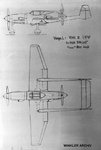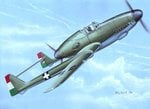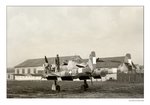johnbr
2nd Lieutenant
In 1943 the Marton XV-01 was developed as a heavy fighter. The twin-boomed tricycle gear design was designed to use two DB 605 engines, one tractor and one pusher. It was to be armed with a 30mm engine-mounted cannon, two heavy machine guns in the cowling, and additional cannons in the wing roots and boom leading edges. This would make for a very heavy hitting aircraft. The aircraft was to have an ejection seat, designed on a twin rail system powered by a spring. In 1944, the fuselage and wing structure were completed, but they were destroyed in an Allied bombing raid in April 1944.
lso known as the RMI-8 X/V
Data:
Length 10,2 m 10.2 m
Span 11,8 m 11.8 m
Speed 580 km/h (berechnet) 580 km / h (calculated)
Engine 2 × Daimler-Benz DB 605 A mit Startleistung 1475 PS 2 × Daimler-Benz DB 605 A with starting power 1475 hp
Armament 1 × 20-mm- or 30-mm-MK in engine crankshaft, Two 12,7-mm-MGs, 20-mm or 30 mm MK, several 12.7-mm machine guns in wings
Photo is a photoshop.
lso known as the RMI-8 X/V
Data:
Length 10,2 m 10.2 m
Span 11,8 m 11.8 m
Speed 580 km/h (berechnet) 580 km / h (calculated)
Engine 2 × Daimler-Benz DB 605 A mit Startleistung 1475 PS 2 × Daimler-Benz DB 605 A with starting power 1475 hp
Armament 1 × 20-mm- or 30-mm-MK in engine crankshaft, Two 12,7-mm-MGs, 20-mm or 30 mm MK, several 12.7-mm machine guns in wings
Photo is a photoshop.



